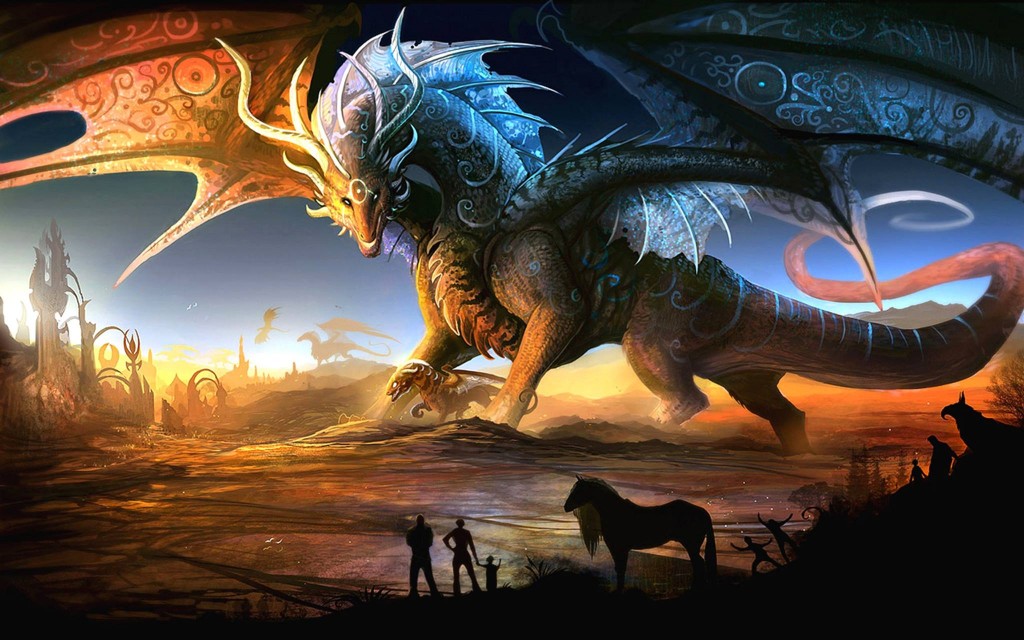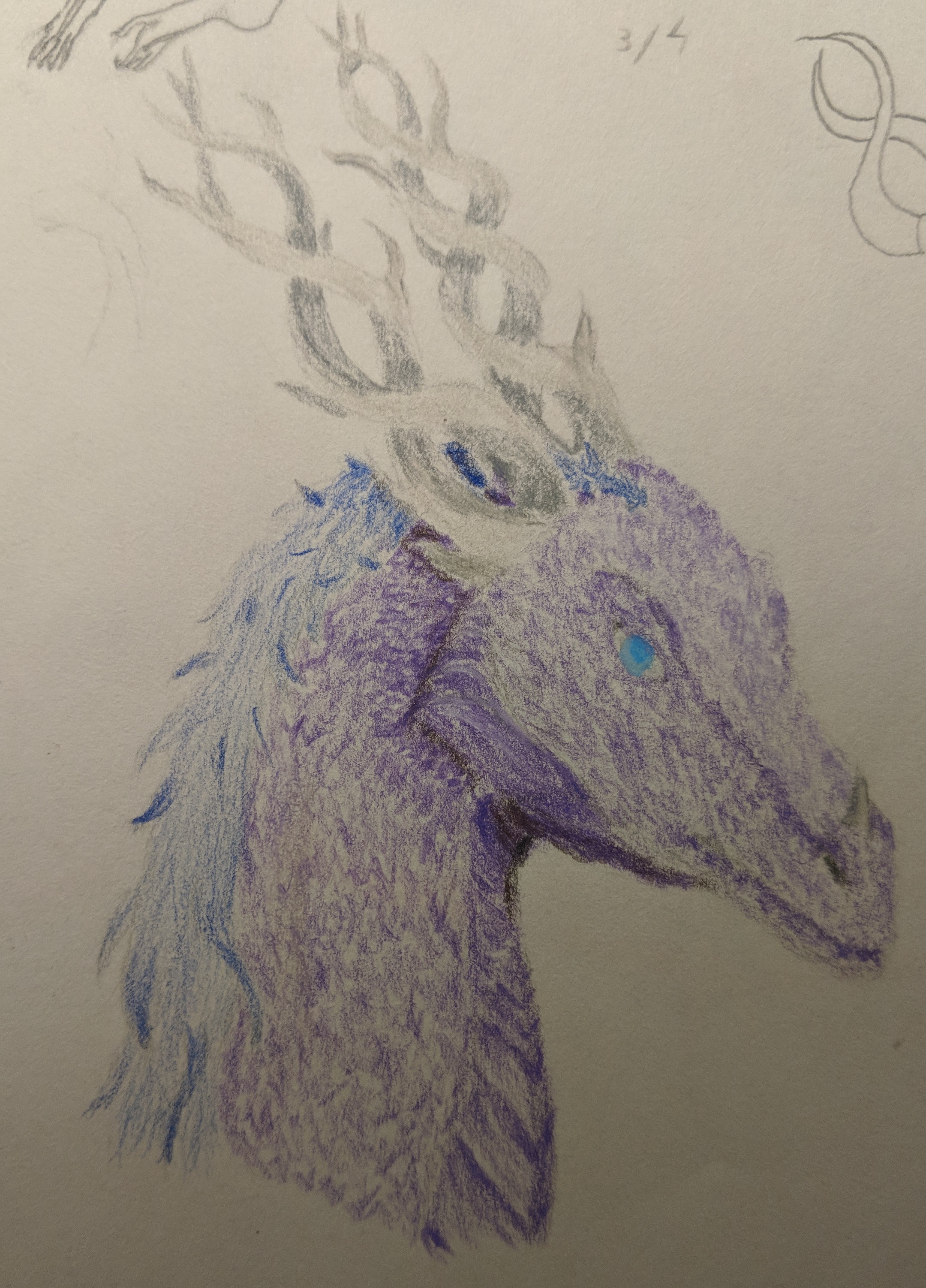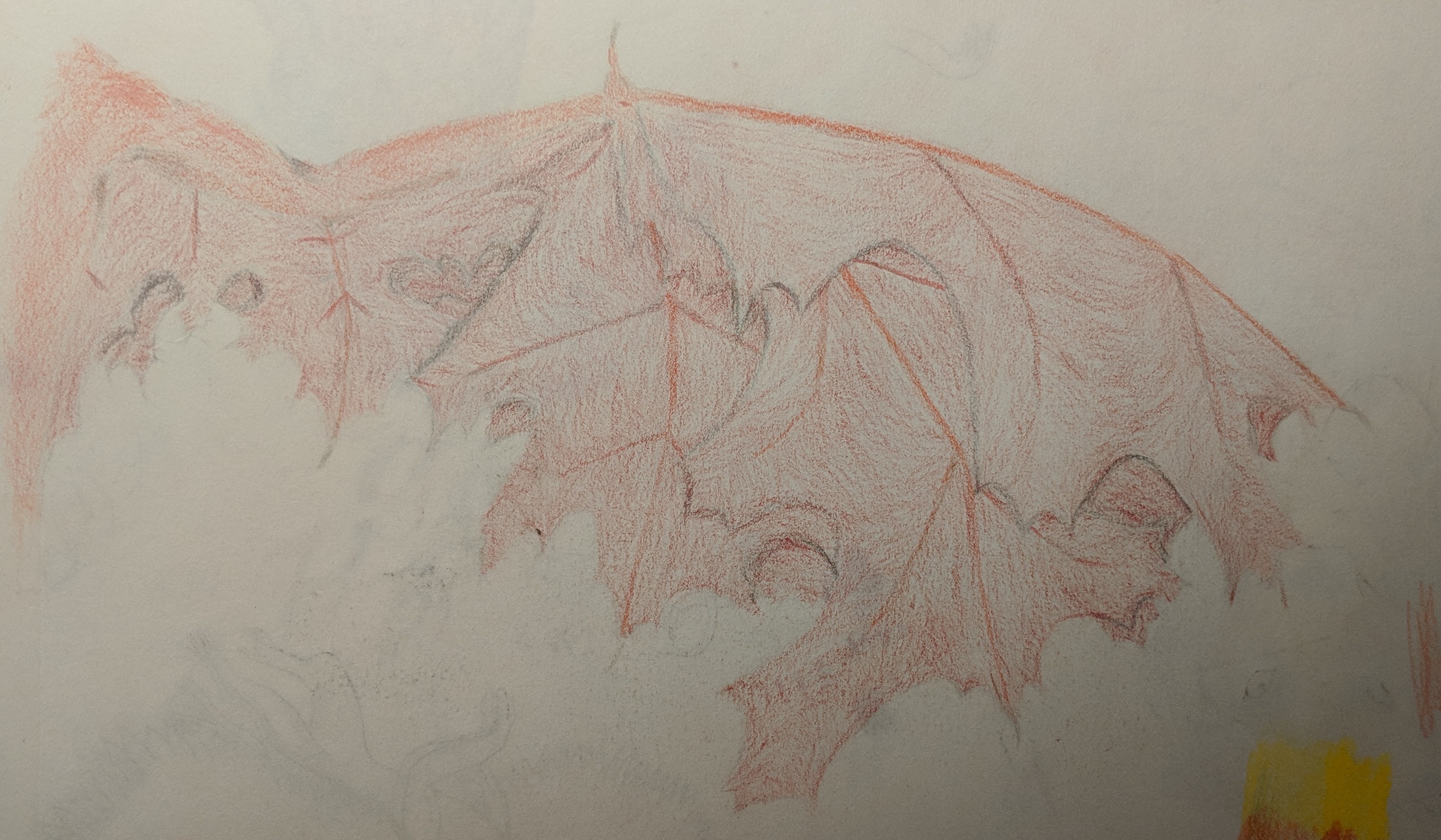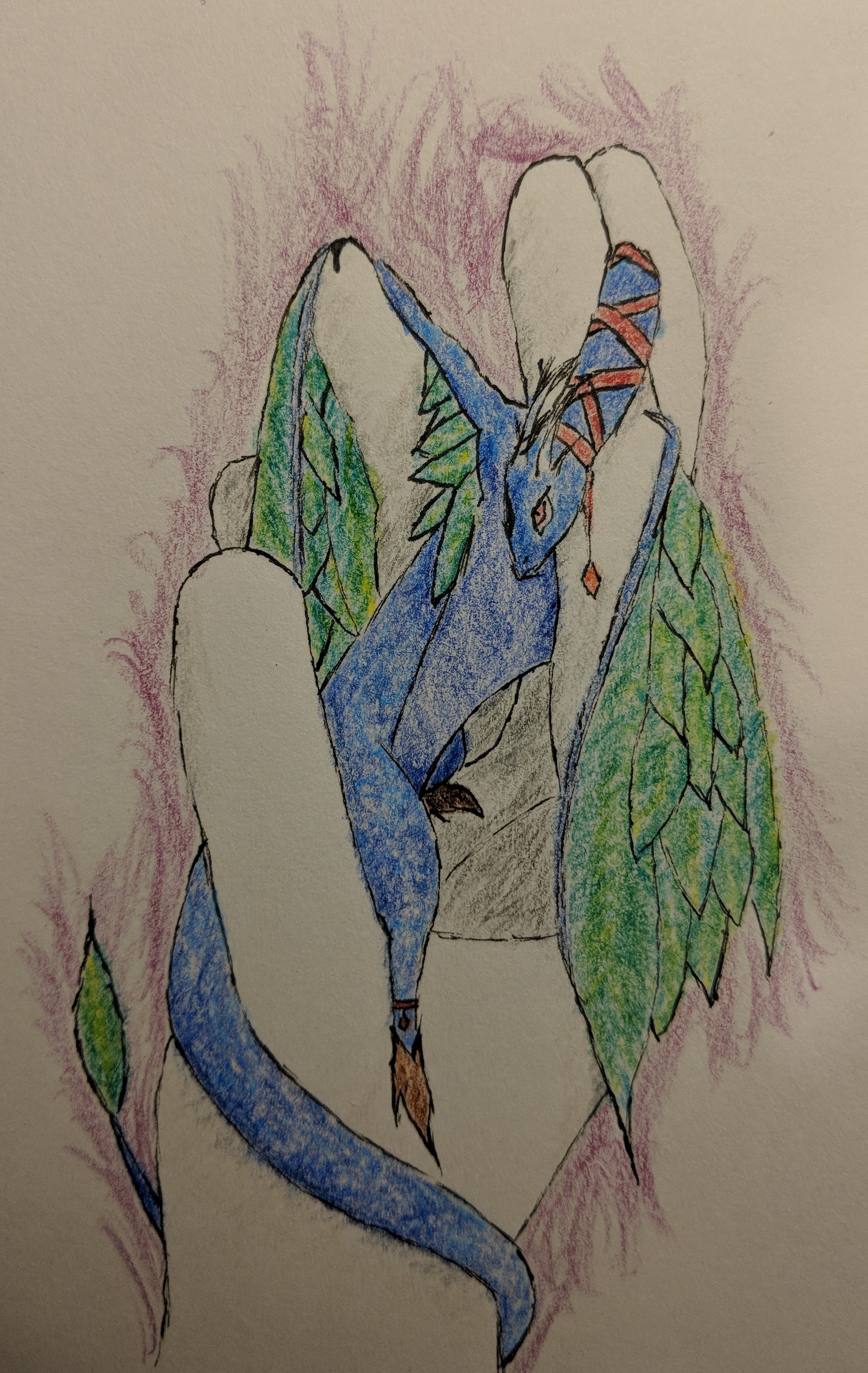Drake
Anatomy & Morphology
While drakes do vary wildly compared to others, they still have some unifying features that tie them together. Their body structure is similar to lizards and birds, some having more traits of one than the other. Some may have feathers, scales, Scaethers, wings, six limbs, or multiple heads.All drake have horns, flame sacs, similarly shaped heads, and long tails. Their horns bud just after birth, growing to full length as they reach maturity. After they reach maturity, their horns grow “branches” for the rest of their lives, looking like bare trees. The branches will continue to grow throughout their life. Older drake that keep their horns are seen as more impressive and desirable.
Females have larger horns while males have more “branches”. Because male’s have more, smaller --thus moe brittle-- branches they are not suited for fighting and are more used for wooing alpha females. Females use their horns for fighting. It’s typical for an aged alpha to have very few branches as most have been broken off due to fighting other aspiring alpha females.
Females have larger horns while males have more “branches”. Because male’s have more, smaller --thus moe brittle-- branches they are not suited for fighting and are more used for wooing alpha females. Females use their horns for fighting. It’s typical for an aged alpha to have very few branches as most have been broken off due to fighting other aspiring alpha females.
Their wings, for those that have, are as birds have, but their “feathers” are quite different. Their “feathers” are layered flaps of hide, cartilage, and muscle, taking the shape of leaves. And their flame sac, located just above their lungs, is used as an auxiliary means of catching prey or fleeing. They collect the energy in the air, building up a storage, letting out old musty flame from their nostrils. Most drake breath fire, yet there are still some who breath sharp gusts of wind, toxins, and other.
A drake’s flame sac collects ambient fire within the air as they breath. The muscles of the flame sac can expel the collected and condensed flames through their throat and out of their mouths. Their whole bodies are flame retardant and the fire does not typically cause harm to the drake. They are also able to control the ambient fire in all things in general (not necessarily collected within the flame sac), though this is more exhausting and needs concentration.
Warm, a common disease for Drake where their flame sack gets infected. Symptoms include making the drake’s body warmer than usual, shortness of breath, coughing, and difficulty expelling contents of the flame sac.
Habits
Dietary Needs & Patterns
They spend most of their times lazing about, hunting about once a week. When they do hunt, they take themselves high into the sky to dive on their prey, grasping them in their talons and/or jaws to breath fire (or whatever their family breaths) on their pray to incapacitate and kill them more swiftly. For those Drake who live in bodies of water, they take a similar approach: they dive as low as they can to rapidly surface pinning their pray in their jaws and/or claws.
Most drake are accurate enough to catch their prey within the first try. But if they are unlucky enough to miss or to go after a prey that fights back, their breaths will help both defend them and weaken their prey.
Mating Rituals & Family
For a drakes nest, there is one alpha female, a chosen male, and the males harem of lesser females. The alpha female can chose at any time to “banish” her male suitor or any in his harem when she pleases, as she holds all the power. Likewise the male can “banish” any in his harem. If the alpha female banishes the male for any reason, she can choose to keep his harem, them no longer permitted to mate with him nor any others that the alpha female blacklists. They act as nursemaids for the rest of their time. And, While modern nests have comradery between the alpha and beta females, there is an instinctual thing for beta females to challenge the alpha to gain nest dominance.
These lesser females could try to leave, but the hormones they produce alert others that they left their nest behind, and thus would have a hard time either creating or joining another harem. The children are bound to their mothers, the firstborn female often taking the role of alpha, while her sisters often become her harem.
It is typical for the alpha female to lay between three and seven eggs, taking about 50 years for the newborns to mature to adulthood. During their growth, each of the male's harem takes guardianship of one or more of the hatchlings, with the alpha female choosing her own first. The alpha female also has the right to first breed, allowing the others by her discretion. The alpha female is the one who stays in the nest and primarily takes care of the hatchlings. Alpha's are both the most prone to leadership (good at arguing as well (or most aggressive in other cultures, etc)) but are also most "motherly".
Male dragons hoard as a show of their worth to potential mates. What items a drake keeps in their hoard is whatever they consider to be "wealth", whether that be money, knowledge, flowers, or something else.
Hygiene
Bathing: Drake use sand or ash to cleanse themselves. If there is no sand near, they burn close vegetation until it is ash and roll around in it, scrubbing their scales.
Etc.
- At one point, dragons were considered royalty and ruled most of the Humi and others.
- Royalty of royalty, black and white drake were families of the ruling class of the drake. It didn’t matter what race they were, as long as their scales were onyx or silver. Royal drake also have power over all drake they meet. A drake is compelled to do whatever the royal tells them, unable to resist.
- A drake, when sad, deflates their flame sac, removing the gathering of fire and letting out fire that would make the sac turgent through their nostrils. This special flame-coated smoke is often referred to as “Ember Smoke”.
- A drake showing their happiness is standing up straight with their neck curved back, chest out.
- Historically, drake cultures are primarily matrilineal. Because of this, names tend to be related to the mother. An example would be @Haseh Hmti where a young drake’s name, typically the first hatched, would be “daughter of parent”. If the parent’s primary name is Ghm, the daughter of Ghm or Ga*gSGhm. Subsequent hatchlings will be named after other nest mothers.
- Drake only have one clutch in their life, after finding a nest. Each nest must be devoid of offspring before the next clutch is had
Genetic Ancestor(s)
Subspecies
Keuh
DragonAverage Lifespan
100-400 years
Appearance
Has six limbs, four legs they walk on and two giant wings they fly withVery thick and tough scales
Much thicker torso and abdomen than serpents or wyverns with shorter tails than both and shorter necks with larger heads
Size
5-70 meters from snout to tail tip (above 30 meters are extremely rare)
Original Ecology & Habitat
Live in hilly and grassy lands, often on the outskirts of steep mountain ranges.Nekeh
Sea DragonAverage Lifespan
100-400 years
Appearance
A Keuh that doesn’t have wings but has many fin like structures on their limbs and bodiesTheir tail splits and widens at the end, making it look like a thin dolphin-like tail
Have rudimentary gills as well as lung to be underwater longer
Slightly longer and thinner bodies than Keuh
Size
5-70
Original Ecology & Habitat
Live in lakes and rivers. They have semi-developed gills to stay underwater for weeks on end.Kakeh
Wingless DragonAverage Lifespan
100-400 years
Appearance
A Keuh with no wings, only four limbs they walk onVery short necks and tails
Size
4-70 meters from snout to tail tip (above 30 meters are extremely rare)
Original Ecology & Habitat
Live near rocky coastlines, mountains, and cave systems.Tmseh
HydraAverage Lifespan
100-350 years
Appearance
Similar to the wingless dragon but with necks having the length of half an entire serpent. Also very long tailMultiple heads with one conscience
Size
12-80 meters from snout to tail tip (above 40 meters are extremely rare)
Original Ecology & Habitat
Reside under the ground.Kohhas
WyvernAverage Lifespan
75-300 years
Appearance
Harder scales than serpents but not as hard as dragons. Have four limbs (two legs and two wings)Size
30-40 centimeters from snout to tail tip
Original Ecology & Habitat
Make their homes in mountainous forestsSohhas
Feathered wyvernAverage Lifespan
75-300 years
Appearance
Similar to the wyvern but have feathers rather than scalesTheir wings are feathers rather than skin flaps
Slightly larger than wyverns because they grew to fly over the treetops
Size
30-50 centimeters from snout to tail tip
Original Ecology & Habitat
Live in deep forests, jungles, and swamps.Lehs
SerpentsAverage Lifespan
200-500 years
Appearance
Long snake like creatures without horns and have four to eight small limbsSize
7-30 meters from snout to tail tip
Original Ecology & Habitat
Spend most of their time flying through the sky, stopping to rest and making their nests in chunks of floating earth.Sohles
Winged SerpentsAverage Lifespan
200-500 years
Appearance
Serpents where rather than claws or fins they have wingsThese wings can either be feathered or skinned
Size
7-30 meters from snout to tail tip
Original Ecology & Habitat
Spend their whole lives aloft in the air.Neles
Water serpentsAverage Lifespan
200-500 years
Appearance
Just like Lehs but have fins rather than clawsThey also have gills and softer scales than serpents
Size
7-30 meters from snout to tail tip








Comments